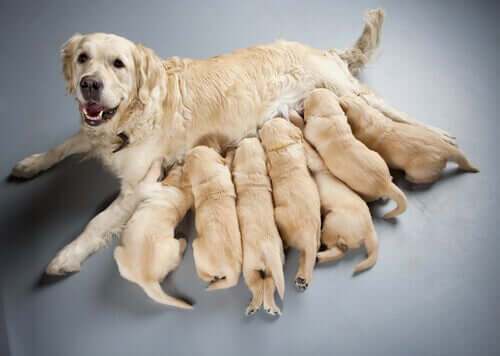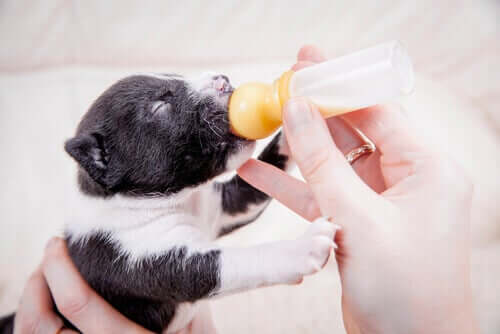9 Care Tips for Pregnant and Lactating Dogs

Being pregnant and lactating are two extremely important stages in the life of female dogs. This makes it crucial for you to be well-informed on how to keep them healthy while they’re in these stages. Read on for some tips to follow if your dog is going through them, or you just want to be ready.
Pregnancy in female dogs
A dog’s gestation period is usually about nine weeks long. In general, the recommendation is to have a veterinarian monitoring your dog throughout her pregnancy. As those nine weeks go by, there will be new steps to incorporate into your routine.
Modifying her diet
You won’t start to see any major change in her weight until about the fifth or sixth week of pregnancy. This is around the time that you need to change her diet. The idea is for her puppies to be getting all the nutrients they need.
To do that, you’ll start to progressively increase the amount you feed her. This process starts in the 5th week and ends in the 9th. By the end, she should be getting about 1/3 more food than usual.
But you also need to take into account her physical health before the pregnancy began. Weight problems and illnesses can be limitations when it comes to changing her diet. These are cases where you should strictly follow your vet’s recommendations.
Keep her hydrated
Your female dog needs to remain hydrated and frequently drink water. Make sure her water bowl always has clean, fresh water in it.
If you feed her some type of dry food, you also need to make extra sure that she has constant access to water. This is especially important in the last few weeks of her pregnancy.
Exercise
It’s good to make sure she does light exercise throughout her pregnancy. The best way to achieve that is to take her on walks every day. Go shorter distances, and for less time than usual.
Comfort above all
As her due date approaches, you make her a little corner with sheets and towels, in a cardboard box called her “nest.” She can give birth there calmly and without stress. The purpose of this nest is to make sure she feels safe and comfortable.
Lactation in female dogs
While still pregnant, female dogs will begin lactating in preparation for their puppies. Newborns still have a lot of development to do, and are far from independent at first. This means they need a lot of special care and dedication.

Always make sure to follow these tips:
Keep their temperature regulated
Puppies aren’t able to properly regulate their body temperature. That can cause some serious health problems for them.
So, you need to make sure you keep your puppies at a stable temperature. Don’t let their body temperature go down too far, because it could slow down their digestion and they may lose their instinct to suckle milk from their mother.
The ideal temperature for a puppy is around 93.2ºF. This temperature allows them to properly suckle and digest milk. If it’s anywhere between 89.6-93.2ºF, it will be able to suckle, but not digest. Warm your puppies up to 93.2ºF or above before you feed them.
Keep them hydrated
Puppies are made up of 82% water, and their internal body temperature and water levels are constantly going down. Try to keep them in a humid environment. The ideal number is 60%. Lower than that could lead to dehydration, and higher could lead to bacterial growth. Take their temperature several times a day.
Keep track of the food you give them
Newborn puppies aren’t fully able to regulate their blood sugar levels. If you want to make sure they have a proper diet and keep their blood sugar in check, make sure you feed them frequently, and with very specific proportions of the nutrients they need.
An immature immune system
Puppies need colostrum, or first milk, so that they can get their mother’s antibodies, because they don’t get them from the placenta. This means that right after their birth, they still have an immature immune system.
You have to have rigorous hygiene standards at home to avoid health problems. Keep the puppies in a clean, sanitary environment and make sure they get that first milk as soon as possible.
We should also mention that their digestive systems aren’t fully functional at this point either. They can’t digest starches, or defecate the way adults do.
What type of milk should it have?
From the moment it’s born until it’s weaned, a puppy should have nothing but milk. That being said, puppies don’t digest all types of milk in the same way.

You should never give a puppy cow’s milk. It’s different from dog’s milk, and that difference can cause intestinal problems in a puppy because of the high lactose content. It can also lead to growth problems because it doesn’t have the right nutrients.
If for any reason a puppy can’t drink its mother’s milk, there are synthetic products you can turn to. You can find formula milk in most stores, and it’ll cover the puppy’s basic nutritional needs and protect its digestive system. You should also give it a DHA supplement. It’s a fatty acid present in dog’s milk, as well as their retinas and brain.
Conclusions about pregnant and lactating dogs
We want to remind you that all these tips are meant to be a broad guide. Each dog’s pregnancy and lactation stages have particular characteristics, which you should address with your vet. We wanted to give you this information about pregnant and lactating dogs to help keep the process as stress-free as possible.
All cited sources were thoroughly reviewed by our team to ensure their quality, reliability, currency, and validity. The bibliography of this article was considered reliable and of academic or scientific accuracy.
-
Consejos para un embarazo saludable de tu perra [Internet]. PURINA®. [citado 18 de agosto de 2019]. Disponible en: https://www.purina.es/perros/salud-y-nutricion/embarazo/consejos-para-embarazo-saludable-perra
-
Embarazo en perros: síntomas más habituales para detectarlo y consejos | Vets & Clinics [Internet]. [citado 18 de agosto de 2019]. Disponible en: https://www.affinity-petcare.com/vetsandclinics/es/embarazo-en-perros-sintomas-mas-habituales-para-detectarlo-y-consejos